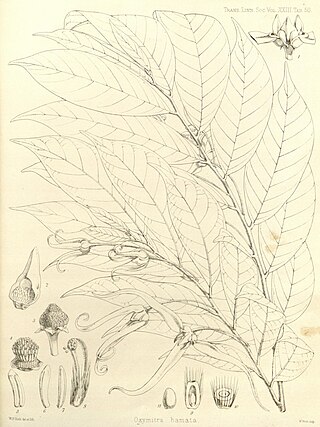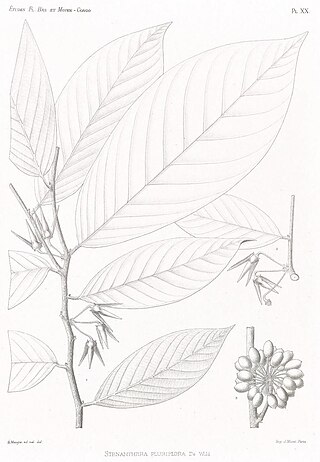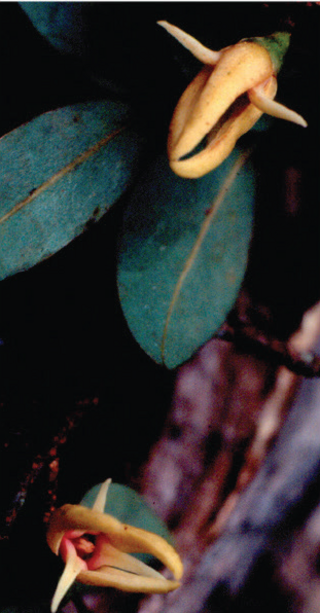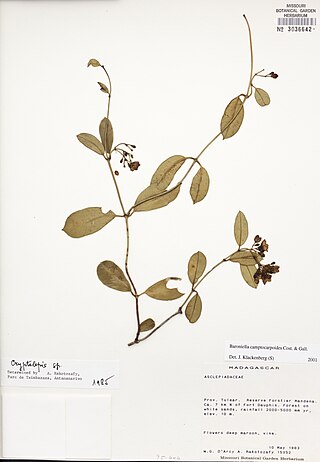
Neostenanthera hamata is a species of plant in the family Annonaceae. It is found in Ivory Coast, Ghana, Liberia, and Sierra Leone. George Bentham, the English botanist who first formally described the species, using the basionym Oxymitra hamata, did not explicitly explain the specific epithet, but it has distinctive outer petals with hooked tips.
Annona angustifolia is a species of plant in the Annonaceae family. It is native to Brazil. Jacques Huber, the Swiss-Brazilian botanist who first formally described the species, named it after its narrow leaves.

Annona crassivenia is a species of plant in the family Annonaceae. It is native to Cuba. William Edwin Safford, the American botanist who first formally described the species, named it after the thick tertiary veins that interconnect the secondary veins of its leaves.
Goniothalamus expansus is a species of plant in the family Annonaceae. It is native to Thailand and Vietnam. William Grant Craib, the British botanist who first formally described the species, named it after its expanded stigmas.
Goniothalamus latestigma is a species of plant in the family Annonaceae. It is native to Myanmar and Thailand. Cecil Ernest Claude Fischer, the botanist who first formally described the species, named it after its broad stigmas.

Goniothalamus malayanus is a species of plant in the family Annonaceae. It is native to Borneo, the Malay Peninsula, the Nicobar Islands, Sumatra and Thailand. Joseph Dalton Hooker and Thomas Thomson, the British botanists who first formally described the species, named it after part of its habitat range, British Malaya.

Goniothalamus monospermus is a species of plant in the family Annonaceae. It is native to Fiji. Asa Gray, the American botanist who first formally described the species using the basionym Richella monosperma, named it after its fruit's solitary seed which have notable wing-like fringes.
Goniothalamus tavoyensis is a species of plant in the family Annonaceae. It is native to Myanmar and Thailand. Debabarta Chatterjee, who first formally described the species, named it after a town in Myanmar that at the time was called Tavoy, but has since be renamed Dawei.
Goniothalamus tortilipetalus is a species of plant in the family Annonaceae. It is native to Peninsular Malaysia and Thailand. Murray Ross Henderson, the Scottish botanist who first formally described the species, named it after its twisted petals.
Goniothalamus velutinus is a species of plant in the family Annonaceae. It is native to Borneo. Herbert Airy Shaw, the English botanist who first formally described the species, named it after the dense velvety hair on its branchlets and petioles.
Hexalobus bussei is a species of plant in the family Annonaceae. It is native to Cameroon. Ludwig Diels, the German botanist who first formally described the species, named it after another German botanist, Walter Busse, who collected the sample that Diels examined.
Mitrephora pallens is a species of plant in the family Annonaceae. It is native to Vietnam. Suzanne Jovet-Ast, the French botanist who first formally described the species, named it after its pale flowers.
Monodora crispata is a species of plant in the family Annonaceae. It is native to Cameroon, Equatorial Guinea, Gabon, Ghana, Guinea, Ivory Coast, Liberia, Nigeria, and Sierra Leone. Heinrich Gustav Adolf Engler, the German botanist who first formally described the species, named it after its curled petal margins.

Monodora angolensis is a species of plant in the family Annonaceae. It is native to Angola, Cameroon, Central African Republic, Democratic Republic of the Congo, Equatorial Guinea, Gabon, Ivory Coast, Nigeria, Republic of the Congo, Sudan, Tanzania, Uganda, Zambia and Zaire. Friedrich Welwitsch, the Austrian botanist who first formally described the species, named it after Angola where he found it growing near the town of Pungo-Andongo.

Neostenanthera myristicifolia is a species of plant in the family Annonaceae. It is native to Benin, Cameroon, The Central African Republic, The Democratic Republic of the Congo, Equatorial Guinea, Gabon, Nigeria, and The Republic of the Congo.
Pseuduvaria mulgraveana is a species of plant in the family Annonaceae. It is native to Australia. L.W. Jessup, the botanist who first formally described the species, named it after the Mulgrave River in Goldsborough, Queensland where the specimen he examined was collected.

Xylopia arenaria is a species of plant in the Annonaceae family. It is native to Kenya, and Tanzania. Adolf Engler, the botanist who first formally described the species, named it after its growth in sandy places.

Baroniella camptocarpoides is a species of plant in the Apocynaceae family. It is endemic to Madagascar. Julien Noël Costantin and Ernest-Isidore Gallaud, the botanists who first formally described the species, named it after its resemblance to, but distinctiveness from, plants in the genus Camptocarpus.
Baroniella capillacea is a species of plant in the Apocynaceae family. It is endemic to Madagascar. Jens Klackenberg, the botanist who first formally described the species, named it after very narrow or thread-like leaves.

Batesanthus pseudopalpus is a species of plant in the Apocynaceae family. It is native to the Republic of the Congo and Gabon. Hendrik J. T. Venter and Rudolf L. Verhoeven, the botanists who first formally described the species, named it after the lobes of its corona which they said resemble the pedipalps of the rain spiders Palystes castaneus and Palystes superciliosus.










